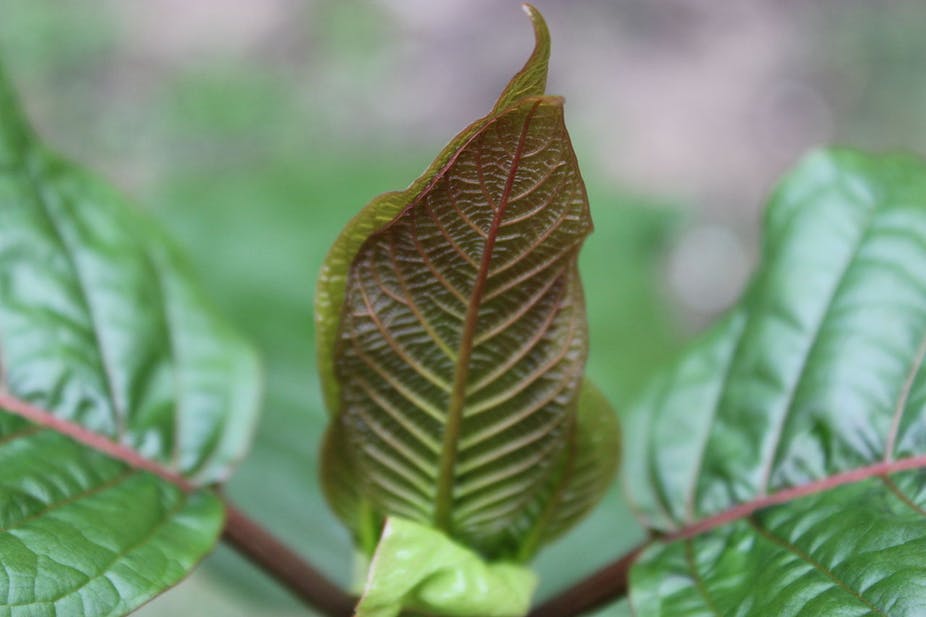While we have seen a surge in new psychoactive substances in recent years, there has also been a rediscovery in the West of old herbal narcotics that have traditionally been used in different parts of the world. One example is khat, the leaves of which are chewed for a mild stimulant effect in some societies in the Horn of Africa – it was banned in the UK in 2014. Another plant to come to the attention of the authorities is kratom, a tropical tree from Southeast Asia that has just been banned by the US Drug Enforcement Agency.
Kratom (Mitragyna speciosa) is a tropical tree that grows between four and 16 metres high and is indigenous to Southeast Asia, the Philippines and New Guinea. Like coca leaves in the central Andes, the chopped fresh or dried leaves of the kratom tree have been chewed for centuries or made into tea to combat fatigue.
The DEA’s ban places kratom as a schedule 1 controlled substance, alongside drugs like cannabis, heroin, MDMA (ecstasy) and LSD. It joins an ever-expanding list of psychoactive drugs deemed to have “no currently accepted medical use” and a “high potential for abuse”. There has been quite an uproar about this among kratom users, although both the arguments for and against lack consistent evidence.
The effects of kratom
The effects of kratom on humans are dose-dependent: small doses produce stimulatory effects resembling cocaine or amphetamines, while larger dosages tend to produce sedative-narcotic effects similar to opiate drugs such as opium, morphine or heroin. Kratom has become more popular in the West in recent years, especially among those seeking a more “natural high”. On the other hand, in Thailand and Malaysia, kratom was made illegal in 1943 and 2015 respectively.
Some kratom users claim that preparations can be used to treat opiate addictions. But data to support its effectiveness and safety is scarce, especially considering that these claims have been made on anecdotal evidence and have not followed the usual rigorous scientific procedures.
The chemistry of natural products is exceptionally complex, producing complex pharmacological effects. With scant data on the toxicology or safety profile of kratom, and even less regarding its interactions with conventional drugs or the effects of abusing it, there is ample risk for it to cause harm or even death by misadventure. So the question is not why the DEA considers kratom a menace to public health – which it at least has the potential to be – but rather why the agency continues to add psychoactive substances, new or newly rediscovered, to its lists of scheduled drugs.
The pointlessness of drug listing
The idea that an ever-expanding list of thou-shalt-nots has any effect on public health has not only been proven to be ineffective, it might even be counterproductive if not put in place as part of an across-the-board harm assessment. Kratom is a powerful opioid receptor agonist, which means that its supposed beneficial effect on opioid withdrawal symptoms stem from the fact it attaches to the same neurotransmitter receptors in the brain. In other words, it stimulates similar areas of the brain and mimics the effects of opiates, if not their toxicity.
Even taking the medicinal argument in support of kratom at face value, we should still require the same level of evidence required for any other substances used to help opiate withdrawal – methadone for example. The only study to support this claim is from a single country (Malaysia), is purely observational, and has a small sample size of just 136 people.

Both the DEA and kratom users are missing the point: neither banning nor legalising/decriminalising the drug will tackle the public health concerns that it might pose. The DEA conducts enforcement, not realising that whether or not kratom is banned, there will still be health effects that must be dealth with by health policy, not criminal justice. On the other hand, those in support of legalising or decriminalising kratom do not have a clear alternative of how to deal with the health effects that would follow.
Only a tiny minority of people use kratom in the West, and it is a drug most people will have never heard of. Users have shown themselves to be very vocal minority, with many belonging to a new type of online activist who favour volume over facts. The case for a medicinal use of kratom comes down to considerable wishful thinking.
When the DEA and its equivalent in other countries insist on banning substances this generally does little to interrupt supply. And it certainly ignores the heart of the issue: why people use drugs, what are the public health implications, how to engage with users effectively – particularly in a case such as this where there are such polarised views – and how to move debates on in a world where facts have become secondary to pursuing agendas.
At the end of the day, public policy is there to change behaviour for the good of society. The DEA has consistently tried to do so through banning and enforcement, but this has produced the opposite effect: drugs have never been more widespread, alongside the social damage from enforcement and health effects that are a consequence. In short, how long will we persist in fighting a lost drug war?

